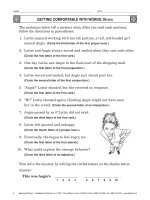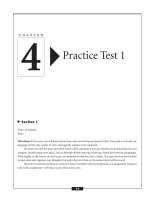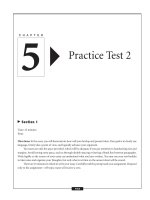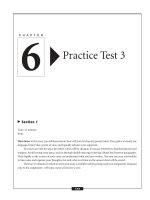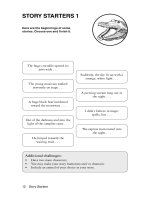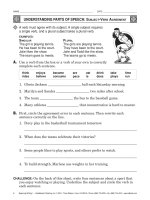SAT writing essentials part 3 pot
Bạn đang xem bản rút gọn của tài liệu. Xem và tải ngay bản đầy đủ của tài liệu tại đây (121.39 KB, 17 trang )
CONFUSED WORDS
WORD DEFINITION
cooperation (noun) assistance; help
corporation (noun) type of business organization
decent (adj.) well mannered
descent (noun) decline; fall
dissent (noun) disagreement
desert (noun) arid, sandy region
dessert (noun) sweet served after a meal
disburse (verb) to pay
disperse (verb) to spread out
disinterested (adj.) impartial; no strong opinion either way
uninterested (adj.) don’t care
elicit (verb) to stir up
illicit (adj.) illegal
envelop (verb) to surround; to cover completely
envelope (noun) flat paper container for letters or other documents
farther (adv.) beyond
further (adj.) additional
flack (noun, verb) press agent (noun); to act as a press agent (verb)
flak (noun) criticism
forth (adv.) forward; onward
fourth (adj.) next in number after the third
hear (verb) to perceive by the ear
here (adv.) in this or at this place
hoard (verb) to collect and keep
horde (noun) a huge crowd
imply (verb) to hint or suggest
infer (verb) to assume; to deduce
–THE MULTIPLE-CHOICE SECTION–
25
CONFUSED WORDS
WORD DEFINITION
loose (adj.) not restrained; not fastened
lose (verb) to fail to win; to be deprived of
loath (adj.) reluctant
loathe (verb) to feel hatred for
medal (noun) a badge of honor
meddle (verb) to interfere
metal (noun) a mineral substance
passed (verb) the past tense of past
past (adj.) finished; gone by
personal (adj.) individual
personnel (noun) employees
principal (adj.) main
principal (noun) person in charge
principle (noun) standard
quiet (adj.) still; calm
quit (verb) to stop; to discontinue
quite (adv.) very; fairly; positively
stationary (adj.) not moving
stationery (noun) writing paper
taught (verb) the past tense of teach
taut (adj.) tight
than (conj., prep.) in contrast to
then (adv.) next
their (pronoun) belonging to them
there (adv.) in a place
they’re contraction for they are
–THE MULTIPLE-CHOICE SECTION–
26
CONFUSED WORDS
WORD DEFINITION
to (prep.) in the direction of
too (adv.) also; excessively
two (adj.) the number after one
weather (noun, verb) atmospheric conditions; to last or ride out
whether (conj.) if it be the case; in either case
who (pronoun) substitute for he, she, or they
whom (pronoun) substitute for him, her, or them
your (pronoun) belonging to you
you’re contraction for you are
–THE MULTIPLE-CHOICE SECTION–
27
MISUSED WORDS
WORD WHEN TO USE IT
allude used when a reference is made indirectly or covertly
refer used when something is named or otherwise mentioned directly
amount used when you cannot count the items to which you are referring, and
when referring to singular nouns
number used when you can count the items to which you are referring, and
when referring to plural nouns
anxious nervous
eager enthusiastic, or looking forward to something
among used when comparing or referring to three or more people or things
between used for two people or things
bring moving something toward the speaker
take moving something away from the speaker
Hint: Remember, you bring to, and you take away.
can used to state ability
may used to state permission
MISUSED WORDS
WORD WHEN TO USE IT
each other when referring to two people or things
one another referring to three or more people or things
e.g. an abbreviation for the Latin exempli gratia,
meaning free example or for example
i.e. an abbreviation for the Latin id est, meaning it is or that is
feel bad used when talking about physical ailments
feel badly used when talking about emotional distress
fewer when you can count the items
less when you cannot count the items
good an adjective, which describes a person, place, or thing
well an adverb, which describes an action or verb
its belonging to it
it’s contraction of it is
Hint: Unlike most possessives, it doesn’t have an apostrophe.
lay the action of placing or putting an item somewhere;
a transitive verb, meaning something you do to something else
lie to recline or be placed (a lack of action); an intransitive verb,
meaning it does not act on anything or anyone else
more used to compare one thing to another
Hint: One of the two can be a collective noun, such as
the ballplayers or the Americans.
most used to compare one thing to more than one other thing
supposably capable of being supposed
supposedly believed to be the case
that a pronoun that introduces a restrictive (or essential) clause
which a pronoun that introduces a non-restrictive (or unessential) clause
Hint: Imagine a parenthetical by the way following the word which
.
“The book, which (by the way) Joanne prefers, is her first novel,”
is incorrect. Therefore, it should read, “The book that Joanne prefers
is her first novel.” “Lou’s pants, which (by the way) are black, are made
of leather,” is correct.
–THE MULTIPLE-CHOICE SECTION–
28
Here are some examples of word choice errors
from the practice tests:
1. Many people believe that the end justifies the
means
, so w
eather their intentions are good or
abc
bad is irrelevant—the result is the only thing
that matt
ers.No err
or.
de
2. If y
ou’r
e bothered by p
esky telemarketers
ab
c
onstantly interrupting you, register with the
c
National Do No Call Registry to add y
ou’re home
d
and/or cell phone number to their list. N
o error.
e
3. Former actor John Robert Powers has had a
huge aff
ect on our culture; after opening the
ab
modeling agency in 1923, he began the first
p
ractice of selling everything from magazines
c
to food items to v
acation destinations with
d
the help of beautiful people. N
o error.
e
Did you spot the errors? In sentence 1, weather is
used incorrectly. It is a noun referring to atmospheric
conditions, and should be replaced by the conjunc-
tion whether. In sentence 2, you’re, a contraction of the
words you are, should be replaced by the possessive
pronoun your. In sentence 3, affect and effect are con-
fused. Affect is a verb meaning “to influence.” The cor-
rect word is effect, a noun referring to result of the
influence.
Adjectives and Adverbs
Because adjectives and adverbs serve similar functions
—they both modify or describe—they are often con-
fused and therefore make good candidates for SAT
questions. Remember that adjectives modify nouns or
pronouns while adverbs modify verbs, adjectives, and
other adverbs. Let’s look at a simple sentence:
The dog barked.
We can modify or describe the noun dog by
adding an adjective such as brown, skinny, or annoying.
We can also describe the action of the dog, the past
tense verb barked, by adding an adverb. Loudly, softly,
and incessantly would all work. Notice that all three
adverbs end in -ly; it’s the most common ending for
these modifiers.
Here are some examples of sentences that confuse
adjectives and adverbs:
1. The game Monopoly, originally called
The Landlord’s Game, was base
d on the
a
economic theories of Henry George, who
proposed a single f
ederally tax based on land
b
ownership; he believed this tax would weaken
the ability to f
orm monopolies, encourage
c
equal opportunity, and narrow the gap between
r
ich and poor.No error.
de
–THE MULTIPLE-CHOICE SECTION–
29
2.The Italian master Artemisia Gentileschi painted
larg
e-scale historical and religious scenes, which
a
were often v
iolently
, in an era when women
b
artists were c
onsigned t
o portrait painting and
c
imitative p
oses.No err
or.
de
3. H
istorians agree that the combat mission was a
ab
fail
ure because the soldiers were inadequate
cd
armed. N
o error.
e
Since you know you’re looking for adjective/
adverb errors, they should have been easy to find. In
the first sentence, the adverb federally (note the -ly end-
ing) is used to modify the noun tax, when the adjective
federal is required. Sentence 2 also uses an adverb (vio-
lently) to describe a noun (scenes). In sentence 3, the
verb armed is described using the adjective inadequate.
Change the adjective to the adverb inadequately to cor-
rect the error.
Some of the most confusing adjectives and
adverbs are included on the list of misused words on
page 23. Note the differences between good and well, feel
bad and feel badly, and more and most. There’s a good
chance you’ll see them on the test.
Another frequently tested issue with adjectives
and adverbs is comparisons. Recall that the compara-
tive form (–er) is used to compare two things. The
superlative (–est) is for comparisons among three or
more things. Whenever you find a sentence that
includes a comparison, check to see how many items
are being compared. For example:
Of the two cross-country trips I’ve taken, I liked
the one to Santa Fe best.
Best might not jump out at first glance as an error;
it doesn’t necessarily sound wrong. But there are only
two things being compared, and that means the com-
parative better is correct.
Strategies for Identifying
Sentence Errors
1. Listen to the sentence. If it sounds wrong to you,
and the error isn’t immediately apparent, think
about how you’d fix it. What change would you
make to improve it?
2. This question type is presented in order of diffi-
culty. Although each question is worth just one
point, the first few will be easier than the last few.
If Identifying Sentence Errors appear first in your
25-minute section, don’t spend too much time
on the difficult ones; it makes more sense to
move ahead to the Improving Sentences section,
where you’ll again encounter the easiest ques-
tions first.
3. Don’t look for punctuation or spelling mistakes;
they’re not being tested in these questions.
4. Be wary of difficult questions (those appearing
last). They’re usually complicated. If an answer
seems obvious, it could be a trick.
5. If you’ve eliminated a choice or two, and still
can’t answer confidently, guess, and move on.
–THE MULTIPLE-CHOICE SECTION–
30
Tip
About 20%, or one in five, of sentences will be error free. If the sentence looks and sounds right to
you, choice
e (no error) is probably correct.
Practice Identifying Sentence
Errors
Directions: Determine which underlined portion, if
any, contains an error in grammar or usage. If the sen-
tence is correct, choose answer e, “No error.” Answers
appear at the end of this chapter.
1. Sheila knew it was important to do w
ell, so for
a
w
eeks before the exam, she fretted, worried,
bc
and was f
eeling anxiety. No error.
de
2. Since the weather has imp
roved, there are less
ab
people interested in w
hiling away the hours in
c
the dar
k of the movie theater. N
o error.
de
3. After he got on the train, he r
ealizes the report
a
he ne
ed
ed to work on was still sitting on his desk
bc
ba
ck at the office. N
o error.
de
4. Only one of the st
udents have finished the book,
ab
and it has b
een three weeks since it was assigned!
cd
N
o error.
e
5. Before b
oarding the cross-town bus, everyone
abc
must have his o
r her ticket. No error.
de
6. Tr inny r
elented and finally gave us the recipe for
ab
that amazing dessert she made last S
aturday, and
c
we can
’
t hardly wait to try it. N
o erro
r.
de
7. N
o matter
how careful
the students handle the
abc
beakers, every year a few g
et br
oken.No err
or.
de
8. In c
o
ntrast to
the high-profile company CEO,
ab
the local business owner did not receive an hono-
rarium for sp
eaking at the monthly meeting of
c
the area b
usiness leaders’ society. No error.
de
9. After three days of heavy r
ain, as predicted the
ab
river overflowed its
banks, and the water creeped
cd
up to our front door. N
o error.
e
10. He’s doing w
ell following the court hearing that
ab
d
etermined whether he should face any criminal
cd
charges. N
o error.
e
–THE MULTIPLE-CHOICE SECTION–
31
Improving Sentences
Improving Sentences questions cover a wide range of
issues, including grammar and usage, sentence struc-
ture and organization, and logic and style. You’ll be
given a sentence with a portion underlined, and have to
determine whether that portion contains an error. If it
does, you must choose the best one of four versions of
the sentence. To do so, you must consider not only
what is correct but also what is the most clear and
effective way to express an idea.
We’ll first look at how these questions are struc-
tured, then review the writing issues you’re most likely
to encounter. Before you try your hand at ten Improv-
ing Sentences questions, you’ll learn the best strategies
for approaching them.
Question Structure
In each Improving Sentences question, part or all of the
sentence will be underlined. Choice a will repeat the
original underlined text. Approximately one in five
times, choice a is the correct answer because the orig-
inal version is the best (the most clear, concise, and cor-
rect) version of the sentence. Answer choices b–e will
offer different versions of the underlined portion of the
sentence. Your task is to determine which choice offers
the best version of the sentence.
Some choices will correct or improve the original
problem, if there is one. Some will continue to make the
same mistake and/or introduce new ones. Only one
choice will be both grammatically correct and the most
clear and concise way to express the idea.
If it sounds like Improving Sentences questions
are a little more complex than Identifying Sentence
Errors, you’re right. Instead of focusing on individual
words or phrases to determine the error, you need to
look at larger structural and stylistic issues within the
sentence to determine the correct answer. Finding that
answer requires two distinct steps: (1) determining
what, if anything, is wrong with the underlined portion
of the sentence and (2) deciding which answer choice
fixes that mistake and does not introduce a new
mistake.
–THE MULTIPLE-CHOICE SECTION–
32
The Top Seven Errors in Improving Sentences
The errors in Improving Sentences cover a wide range of writing issues, including grammar and usage,
sentence structure and organization, and logic and style. Fortunately, the ETS likes to focus on a handful of
specific mistakes. You can expect to see these seven kinds of errors—some of them many times—on test day:
1. improper coordination or subordination of ideas
2. incorrect sentence boundaries
3. faulty comparisons
4. misplaced modifiers
5. wordiness
6. incorrect use of the passive voice
7. incorrect punctuation
The eight most common errors are covered in the Sentence Errors section!
33
Errors You’re Likely to See
Improper Coordination or Subordination
of Ideas
Within sentences, clauses (groups of words containing
both a subject and verb) are often connected by coor-
dination (two independent ideas) or subordination
(one idea depends upon the other):
Coordination: We are going to dinner and
then
we are going to a movie.
Subordination:A
fter we go to dinner, we are
going to a movie.
B
efore we go to a movie, we are
going to dinner.
One of the favorite issues in Improving Sentences
questions is coordination and subordination, because
it tests your ability to see logical relationships between
ideas. To tackle these questions, you need to determine
how the ideas in the clauses work together. Is one idea
in addition to the other? In contrast? Is there a pro-
gression in time or sequence? How exactly does one
idea relate to the other? Here’s an example:
It was snowing, but I wore my boots.
There are two distinct ideas here: (1) It was snow-
ing and (2) I wore my boots. But the relationship
between these ideas isn’t correctly expressed by the
coordinating conjunction but, which expresses con-
trast. Instead, it needs a conjunction that shows the sec-
ond idea is a result of the first:
It was snowing, so I wore my boots.
OR
Because it was snowing, I wore my boots.
Here’s another example:
Henry tried to read War and Peace in the origi-
nal Russian, and it was too difficult.
What’s the relationship between the two ideas?
Contrast. And expresses addition. Here are
three corrected versions:
Henry tried to read War and Peace in the origi-
nal Russian, but it was too difficult.
Although Henry tried to read War and Peace in
the original Russian, it was too difficult.
Henry tried to read War and Peace in the origi-
nal Russian, however it was too difficult.
Because the same idea can often be expressed
with several different conjunctions, be sure you choose
the one that fits the 3C’s (correct, clear, and concise).
There might be two versions that express the right rela-
tionship, but only one will be correct, clear, and concise.
For your review, here are the most common coordi-
nating and subordinating conjunctions:
–THE MULTIPLE-CHOICE SECTION–
34
COORDINATING CONJUNCTIONS
and for
but nor
or so
yet
SUBORDINATING CONJUNCTIONS
after rather than
although since
as so that
as if than
as long as that
as though though
because unless
before until
even if when
even though whenever
if where
if only whereas
in order that wherever
now that while
once
Incorrect Sentence Boundaries
A complete sentence requires a noun and verb, and
expresses a fully developed thought. The two most
common mistakes at the sentence level are extremes.
Sentence fragments stop too quickly; they are phrases
that are not whole thoughts. Run-on sentences don’t
stop soon enough; they include two or more complete
clauses or sentences.
Sentence fragments are often missing a subject or
verb, and may be dependent clauses. They can also be
phrases or parts of other sentences. Fragments are
punctuated as sentences, so they can sometimes be dif-
ficult to identify. Even though they don’t express com-
plete thoughts, they can be long and appear to be
correct. Here are a few examples:
Because she had to stop studying and go to
lacrosse practice.
Cried a lot.
When we finished the game after the sun began
setting.
If you suspect a fragment, look for the version
(choice b, c, d,or e) that expresses a complete thought.
This might require adding a subject or a verb, deleting
a subordinating conjunction (because, while), deleting
a relative pronoun (who, that, which), or connecting a
dependent clause to an independent clause. The frag-
ments above can be corrected as follows:
She had to stop studying and go to lacrosse
practice.
Sheu Ling cried a lot.
We finished the game after the sun began
setting.
Run-on sentences are made up of two or more
independent clauses or complete sentences placed
together into one sentence without proper punctua-
tion. For example:
We were hungry and John was tired so we had
to stop at the first rest area that we saw.
Kim studied hard for the test that’s why he got
an A.
Patty took flying lessons every Saturday so she
couldn’t go to the picnic and she couldn’t go to
the graduation party either but she has already
signed up for another group of flying lessons
because she likes it so much.
If you suspect a run-on sentence, determine if
there are two independent ideas that can stand alone
(just because a sentence is long doesn’t mean it’s a run-
on). Check the answer choices for one of the following
fixes for run-on sentences:
1. Separate the clauses with a period. We are here.
You are not.
2. Connect the clauses with a comma and a coordi-
nating conjunction (and, or, nor, for, but, so,or
yet). Make sure the coordinating conjunction
expresses the right relationship between the two
ideas. We are here, but you are not.
3. Connect the clauses with a semicolon (and pos-
sibly a conjunctive adverb such as however, there-
fore,or otherwise, making sure it expresses the
right relationship between the two ideas). We are
here; you are not.
4. Make one sentence dependent upon the other by
using a subordinating conjunction such as
although, because, since, or while
. Again, make
sur
e the subordinating conjunction expresses the
right relationship between the two ideas.
Although we are here, you are not.
The context of the sentence will determine the
best correction. If the relationship between the clauses
needs to be expressed, then the run-on needs a con-
junction of some sort. The run-ons above can be cor-
rected as follows:
–THE MULTIPLE-CHOICE SECTION–
35
We were hungry and John was tired, so we had
to stop at the first rest area that we saw.
Kim studied hard for the test; that’s why he got
an A.
Patty took flying lessons every Saturday so she
couldn’t go to the picnic. She couldn’t go to the
graduation party either, but she has already
signed up for another group of flying lessons
because she likes it so much.
Faulty Comparisons
Faulty comparisons are errors in sentence logic. They’re
often tough to catch because they sound okay; many
people speak in faulty comparisons all the time. Here’s
an example:
I’ve seen every painting by Jackson Pollack, and
they’re better than any other painter.
You probably understood the sentence to mean
that the paintings by Pollack are better than the paint-
ings by any other artist, but that’s not what the sentence
says. The author is actually comparing the paintings of
Pollack to the other painters, not their paintings. To cor-
rect faulty comparisons, like things must be compared.
I’ve seen every painting by Jackson Pollack, and
they’re better than any other painter’s.
OR
I’ve seen every painting by Jackson Pollack, and
they’re better than paintings by any other artist.
Here’s another example:
I’m more interested in the shoe sale at Macy’s
than in Walmart.
This sentence compares the shoe sale to Walmart
rather than to a sale at Walmart. Here’s the kind of fix
to look for:
I’m more interested in the shoe sale at Macy’s
than in the white sale at Walmart.
OR
I’m more interested in Macy’s shoe sale than in
Walmart’s.
Misplaced Modifiers
A modifier is a word, phrase, or clause that describes
another part of a sentence. A misplaced modifier is
simply in the wrong place in the sentence. The danger
of misplaced modifiers is that they confuse meaning:
I had to have the cafeteria unlocked meeting
with student government this morning.
Did the cafeteria meet with student government?
To say exactly what is meant, the modifying phrase
meeting with student government should be moved to
the beginning of the sentence.
Meeting with student government this morn-
ing, I had to have the cafeteria unlocked.
Wordiness
Whether it’s the main mistake in the original prompt
or a flaw in one or more of the distracters, unnecessary
wordiness is a common error in Improving Sentences
questions. In general, the more concise, the better (as
long as all necessary information is conveyed).
Wordiness has many causes, including:
■
“clutter” phrases such as “because of the fact that”
■
that, which, and who phrases (turn them into
adjectives: “the manual that is helpful” becomes
“the helpful manual”)
■
unnecessary repetition (e.g., “the meeting is at 4
P.M. in the afternoon”—4 P.M. is in the afternoon)
■
inexact phrases (“I am not in agreement” vs.
“I disagree”; “she was very upset” vs. “she was
devastated”)
–THE MULTIPLE-CHOICE SECTION–
36
Here are examples of wordiness, with their more concise counterparts (if there is no concise example, the
word or phrase is unnecessary):
–THE MULTIPLE-CHOICE SECTION–
37
a lot of (many or much)
all of a sudden (suddenly)
along the lines of (like)
are able to (can)
as a matter of fact
as a whole
as the case may be
at the present time (currently or now)
both of these (both)
by and large
by definition
due to the fact that (because)
for all intents and purposes
in order to (to)
in the event that (if)
in the near future (soon)
it is clear that
last but not least (finally)
on a daily basis (daily)
on account of the fact that (because)
particular
somewhere in the neighborhood of (about)
take action (act)
the fact that
the majority of (most)
the reason why (the reason or why)
through the use of (through)
with regard to (about or regarding)
with the exception of (except for)
Some words and phrases don’t need a modifier,
because the specific is implied in the general. For instance,
the word consensus means general agreement. Therefore,
modifying it with the word general is repetitive. Similarly,
mathematics is a field of study, so it does not need to be
modified with the words field of. Review these lists of
repetitive phrases and be ready to spot them more easily
in SAT prompts and answer choices.
RETAIN ONLY THE FIRST WORD DROP THE MODIFIER (FIRST WORD)
any and all past memories
first and foremost final destination
refer back general consensus
close proximity various differences
large in size each individual
often times basic fundamentals
reason why true facts
heavy in weight important essentials
period in time future plans
round in shape terrible tragedy
RETAIN ONLY THE FIRST WORD DROP THE MODIFIER (FIRST WORD)
odd in appearance end result
mathematics field final outcome
cheap quality free gift
honest in character past history
confused state totally obvious
modern in design rarely ever
unusual in nature unexpected surprise
extreme in degree sudden crisis
strange type
–THE MULTIPLE-CHOICE SECTION–
38
Another common problem that leads to wordi-
ness is the use of unnecessary prepositions. When two
or more prepositions are used together, chances are at
least one is unnecessary.
I cleaned up under the kitchen cabinets.
She likes all sports except for soccer.
In both of these sentences, there is an unnecessary
preposition. Here’s how to correct them:
I cleaned under the kitchen cabinets.
She likes all sports except soccer.
Notice how choices a, c, d and e in the following
example all suffer from wordiness. They all use that
clauses and repeat words such as program and called:
T
he American Red Cross offers a program called
the Learn to Swim Program that begins with a
class called Introduction to Water Skills, then
progresses to Fundamental Aquatic Skills.
a. The American Red Cross offers a program
called the Learn to Swim Program that begins
with a class called
b. The American Red Cross’s Learn to Swim Pro-
gram begins with a class called
c. The American Red Cross offers a program that
is called the Learn to Swim Program that
begins
d. The American Red Cross is an organization
that offers a program that is called the Learn
to Swim Program that begins with a class
called
e. The American Red Cross offers a program
called the Learn to Swim Program that begins
with a class called
Incorrect Use of the Passive Voice
You may find one or more prompts or answer choices
that use the passive when the active voice is needed. In
the passive voice, the subject (most often you) is acted
upon. While there are occasions in which it’s correct to
use it, most sentences should be in the active voice. Pas-
sive constructions tend to be wordy or lack focus. Com-
pare these sentences:
Active: My friend asked for another
helping.
Passive: Another helping was asked for by
my friend.
Active: I misplaced my wallet.
Passive: My wallet was misplaced by me.
Active: The administration has selected
three finalists for the open
position.
Passive: Three finalists for the open posi-
tion have been selected by the
administration.
Note the simplicity and directness of the first sen-
tence in each pair. The second sentences, written in the
passive voice, are clunky and noticeably longer. With
very few exceptions, sentences like these should be
quickly eliminated; they’re almost always wrong.
Incorrect Punctuation
Identifying Sentence Errors questions don’t test for it,
but Improving Sentences questions do. (The good news
is, though, that neither tests for spelling!) Keep in mind
when answering these questions that a misplaced or
missing comma, an errant apostrophe, or an unneces-
sary semicolon could be the error you’re looking for.
There are dozens of rules about the many different
punctuation marks in the English language. Fortu-
nately, the punctuation errors on the SAT tend to stick
to three categories: semicolon, comma, and apostrophe
errors.
■
Semicolon Errors
Semicolons (;) are used in two ways: to separate
independent clauses and to separate the items in a
list when those items contain commas.
1. There are three ways to use semicolons to sepa-
rate independent clauses.
First Case: Use a semicolon to separate inde-
pendent clauses joined without a conjunction.
Example:
Four people worked on the project; only one
received credit for it.
Second Case: Use a semicolon to separate inde-
pendent clauses that contain commas, even if
the clauses are joined by a conjunction.
Example:
The strays were malnourished, dirty, and ill; but
Liz had a weakness for kittens, so she adopted
them all.
Third Case: Use a semicolon to separate inde-
pendent clauses that are connected with a con-
junctive adverb that expresses a relationship
between clauses.
Example:
Victoria was frequently tardy; therefore, she
received a low grade.
2. Use semicolons to separate items in a series that
contain commas to show which sets of items go
together.
Examples:
The dates for our meetings are Monday, Janu-
ary 10; Tuesday, April 14; Monday, July 7; and
Tuesday, October 11.
She has lived in Omaha, Nebraska; Nutley, New
Jersey; Amherst, Massachusetts; and Pensacola,
Florida.
–THE MULTIPLE-CHOICE SECTION–
39
■
Comma Errors
There are many rules about when to use and when
not to use commas. Here are the five comma
errors you are most likely to see on the exam:
1. Comma between subject and verb. When a sub-
ject is immediately followed by its verb, nothing
should come between them:
Mary decided to relax with a good book.
2. No comma after introductory phrase or clause.
Introductory phrases and clauses should be fol-
lowed by a comma:
By lunchtime, Aidan had already finished his
project.
After a long day at work, Mary decided to relax
with a good book.
3. No comma around “interrupters.” Words,
phrases, and clauses that “interrupt” the core
sentence (and are not essential to the meaning of
that core sentence) should be set off by commas:
Mary, a pediatrician, really enjoys her work.
The phrase a pediatrician is an “interrupter”: It’s
not essential to the sentence. We could take it out and
the sentence would still be a complete, grammatically
correct idea. Thus, it needs to be set off with commas.
Here’s another example:
Mary, who always wanted to be a pediatrician,
loves her job.
In the following example, the who clause is essen-
tial to the sentence and should not be set off with
commas:
Mary is the one who wrote the prescription.
Here, the purpose of the sentence is to explain
who wrote the prescription, so that clause is essential.
The context of the sentence will help you determine
whether information is essential and therefore whether
commas are needed.
4. Comma separating two independent clauses.
Known as a comma splice, this error is the incor-
rect use of a comma to connect two complete
sentences. It creates a run-on sentence. To correct
a comma splice, you can either:
■
replace the comma with a period, forming two
sentences
■
replace the comma with a semicolon
■
join the two clauses with a conjunction such as
and, because,or so
Comma splice: Our school received an award,
we raised the most money for the local charity.
Corrected sentence: Our school received an
award. We raised the most money for the local
charity.
OR
Our school received an award; we raised the
most money for the local charity.
OR
Our school received an award because we raised
the most money for the local charity.
–THE MULTIPLE-CHOICE SECTION–
40
Its vs. It’s
Unlike most possessives, its does not contain an apostrophe. The word it’s is instead a contraction of the
words it is. The second i is removed, and replaced by an apostrophe. When revising your writing, say the
words it is when you come across it’s or its. If they make sense, you should be using the contraction. If they
don’t, you need the possessive form, its, without an apostrophe.
41
■
Apostrophe Errors
Apostrophes are used to form contractions, indi-
cate ownership, and form certain plurals. Review
these six rules for their use.
1. Apostrophes form contractions by taking the
place of a missing letter or number:
We’re going out of town next week.
Don’t write the proposal without the instruc-
tions from your boss.
My husband was in the class of ’89.
2. Add ’s to form the singular possessive, even when
the noun ends in s:
The school’s lunchroom needs to be cleaned.
The drummer’s solo received a standing
ovation.
Mr. Perkins’s persuasive essay was very
convincing.
3. A few plurals that don’t end in s also form the
possessive by adding ’s:
The children’s toys were found in every room of
the house.
The line for the women’s restroom was too long.
Men’s shirts come in a variety of neck sizes.
4. Possessive plural nouns already ending in s need
only the apostrophe added:
The customers’ access codes are confidential.
The students’ grades improved each semester.
The flight attendants’ uniforms were blue and
white.
5. Show possession in the last word when using
names of organizations and businesses, in
hyphenated words, and in joint ownership:
Brad and Janet’s graduation was three months
ago.
I went to visit my great-grandfather’s alma
mater.
The Future Farmers of America’s meeting was
moved to Monday.
6. Use an ’s to form the plurals of letters, figures,
and numbers used as words, as well as certain
expressions of time and money. The expressions
of time and money do not indicate ownership in
the usual sense:
She has a hard time pronouncing s’s.
My street address contains three 5’s.
He packed a week’s worth of clothing.
The project was the result of a year’s worth of
work.

